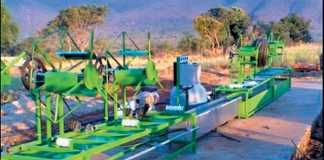Understanding the function and spray patterns of the nozzles on agricultural herbicide spraying equipment is vital to get the best out of these tools against weeds in crop lands. Speaking at the KZN No-till Club’s 2010 conference held recently, TeeJet Technologies’s Grant Orsmond explained that the three functions of a spray nozzle are to control the application rate of a herbicide onto a land, form the correct sized droplets, and disperse these droplets in specific patterns.
“The three typical spray patterns given by different nozzle types are a flat spray, a hollow cone and a full cone,” says Grant. “But the shape and accuracy of a spray pattern can become faulty, and the nozzle should be replaced if the flow exceeds its factory rating by 10%. “A nozzle can’t spray properly if it hasn’t been cleaned properly. Each nozzle on a boom spray should be checked against another, or against several new nozzles, to confirm that it’s spraying correctly. Use an accurate calibration container for this.”
The correct nozzle for the job
For correct spray-nozzle function, the aim is to get the lowest coefficient of variation (CV) between nozzles along a boom. There should also be a 30% minimum overlap for spray uniformity along a boom. New spray nozzles generally have a 6% CV, producing a uniform spray distribution when properly overlapped. But the CV on worn nozzles is around 35%, and they produce a higher spray output with the spray concentrated under each nozzle tip. Damaged nozzles can have a 57% CV, with a very erratic spray output. Some will over-apply, others will under-apply spray.
“Each nozzle-tip material has its own characteristics and cost,” says Grant. “Ceramic tips have superior wear life, and are highly resistant to abrasive and corrosive chemicals. Stainless-steel tips have good wear life, excellent resistance to chemicals, and a durable orifice. Polymer tips have good wear life and resistance to chemicals, but the orifice can be damaged if not cleaned properly.”
Hardened stainless-steel tips have a very good wear life, and good durability and resistance to chemicals. Brass tips have poor wear life and are susceptible to corrosion, especially from fertiliser.To minimise mechanical damage to spray nozzles, clean them with an old, soft toothbrush, or even with compressed air.
Droplet size
According to TeeJet Technologies, at a given pressure a spray tip will produce a specific droplet size measured in micron (µ) – 1 000µ being 1mm. In common terms, 2 000µ is the thickness of a #2 pencil lead; 850µ the thickness of a paper clip, 420µ the thickness of a staple, 300µ the thickness of a toothbrush bristle, 150µ the thickness of sewing thread, and 100µ the thickness of a human hair.“In droplet size terminology, Dv0.1 means that the volume of 10% of the droplets is smaller than the size indicated on the nozzle,” explains Grant.
“Dv0.5 means that the percentage is 50% , while Dv0.9 means that the percentage is 90%. “The volume median diameter (VMD), also known as Dv5.0, indicates the percentage difference between smaller and larger droplets.” The typical standard for spray nozzle droplet size and measurement classification was devised by the American Society of Agricultural Engineers. It’s classed into: VF – very fine (typically coloured red), F – fine (orange), M – medium (yellow), C – coarse (blue), VC – very coarse (green), and XC – extremely coarse (white).
The drift dilemma
When spraying crops, most farmers face drift. This is where wind blows the spray of chemicals away from the desired target. Drift is especially frustrating because more droplets in a spray gives better spray coverage on the target. But more droplets mean smaller and lighter droplets that wind can easily blow away.
Environmental factors affecting drift include wind speed and direction, temperature and relative humidity. Spray characteristics influencing drift include the formulation of the chemical being applied, additives added to the chemical, spray droplet size and evaporation. Equipment and application factors include the nozzle type and size, operating pressure, and the height of the spray boom above the target.
To achieve spray coverage while reducing drift, select nozzles that generate larger droplets and lower the spray boom height. Select the appropriate spray nozzle for the sprayer’s travel speed. “Weather conditions, the setup of a sprayer, and correct spray nozzle are the most important influences on drift,” Grant says.
“Drift reduction technology is now available. TeeJet has new high-tech air induction nozzles that reduce the driftable fines in a spray and generate consistent droplets across a range of pressures and across the series of spray tips. This technology also gives a wide spray angle.” Use fine droplets for post-emergence contact applications, medium to coarse droplets for post-emergence systemic herbicides or for pre-emergence surface-applied herbicides.
Contact Grant Orsmond of TeeJet Technologies on 083 229 4724 or e-mail [email protected].












